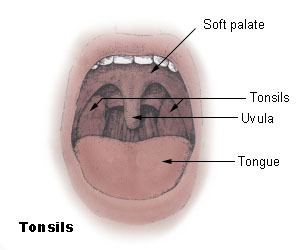MeSH A14.549.617.780 | FMA 55021 | |
 | ||
Nerve pharyngeal branch of vagus nerve, medial pterygoid nerve, lesser palatine nerves, glossopharyngeal nerve Latin palatum molle, velum palatinum TA A05.1.01.104A05.2.01.003 | ||
The soft palate (also known as the velum or muscular palate) is, in mammals, the soft tissue constituting the back of the roof of the mouth. The soft palate is distinguished from the hard palate at the front of the mouth in that it does not contain bone.
Contents
Muscles
The five muscles of the soft palate, play important roles in swallowing and breathing. The muscles are:
- Tensor veli palatini, which is involved in swallowing
- Palatoglossus, involved in swallowing
- Palatopharyngeus, involved in breathing
- Levator veli palatini, involved in swallowing
- Musculus uvulae, which moves the uvula
These muscles are innervated by the pharyngeal plexus via the vagus nerve, with the exception of the tensor veli palatini. The tensor veli palatini is innervated by cranial nerve 5 branch V3 (which is the mandibular division of the trigeminal cranial nerve).
Function
The soft palate is moveable, consisting of muscle fibers sheathed in mucous membrane. It is responsible for closing off the nasal passages during the act of swallowing, and also for closing off the airway. During sneezing, it protects the nasal passage by diverting a portion of the excreted substance to the mouth.
In humans, the uvula hangs from the end of the soft palate. Research shows that the uvula is not actually involved in the snoring processes. This has been shown through inconsistent results from uvula removal surgery. Snoring is more closely associated with fat deposition in the pharynx, enlarged tonsils of Waldeyer's ring, or deviated septum problems. Touching the uvula or the end of the soft palate evokes a strong gag reflex in most people.
Speech
A speech sound made with the middle part of the tongue (dorsum) touching the soft palate is known as a velar consonant.
It is possible for the soft palate to retract and elevate during speech to separate the oral cavity (mouth) from the nasal cavity in order to produce the oral speech sounds. If this separation is incomplete, air escapes through the nose, causing speech to be perceived as nasal.
Modelling
Within the microstructure of the soft palate, lie a variety of complexly oriented fibers that create a nonuniform surface with a nonuniform density distribution. The tissue has been characterized as viscoelastic, nonlinear, and anisotropic in the direction of the fibers. Young modulus values range from 585Pa at the posterior free edge of the soft palate to 1409Pa where the soft palate attaches to the maxilla. These properties are useful when quantifying the effects of corrective orthopedic devices such as the Hotz Plate on cleft lip.
Quantitative analyses have been done on bilateral and unilateral cleft palate to better understand geometric differences in cleft palate throughout the course of its development and correction. Despite the difficulty in finding common, comparable landmarks between normal soft palates and cleft palates, analytical methods have been done to assess differences in degree of curvature of the alveolar crest, 2-dimensional and 3-dimensional surface area, and slope of the alveolar crest.
Finite element analysis has demonstrated effective modeling of soft-palate extension and movement. It has also been an effective tool for evaluating the craniofacial effects of corrective orthopedic devices and cleft lip.
Disease
Pathology of the soft palate includes mucosal lesions such as pemphigus vulgaris, herpangina and migratory stomatitis, and muscular conditions such as the congenital cleft palate and cleft uvula.
Petechiae on the soft palate are mainly associated with streptococcal pharyngitis, and as such it is an uncommon but highly specific finding. 10 to 30 percent of palatal petechiae cases are estimated to be caused by suction, which can be habitual or secondary to fellatio.
